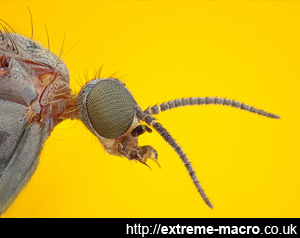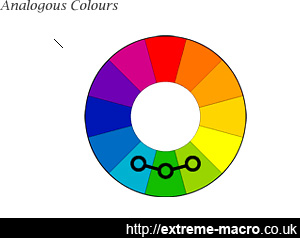Single Colour Background
by Johan J Ingles-Le Nobel
Last updated August 31, 2017
The single colour background is more than adequate for the overwhelming majority of extreme macro shots. Less is sometimes more, and a simple and analogous background usually works extremely well.
Making a Background

The single colour background: simple and effective. But finding the right colour for your background can be surprisingly difficult. Coloured paper works perfectly well as a plain one colour background and is very cheap to purchase.
The most obvious of background materials to use, coloured paper works perfectly well as a plain one colour background and is very cheap to purchase. You can usually find a good variety of paper in a local artist shop and I tend to go towards slightly thicker sheets, more for durability than anything else.
You can alter the shade of the colour by both feathering it with a flash unit, and also to some degree by angling the paper. Another way to achieve a single colour is the use of flash gels on a white piece of paper.
Both paper and flash gels have the advantage that you're not mixing ambient and flash lighting, with the complications that come from that. For example, you don't need to have a rear sync flash if you're not mixing light sources.
Alternatively, you could use a field monitor to output a photoshop colour which gives you a lot more adjustability whilst taking your photo.
Colour Schemes

Analogous colour schemes seem to work very well. An analogous colour scheme uses colours that are adjacent to each other on the colour wheel. One colour is used as a dominant colour while others are used to enrich the scheme. Adjacent colours are naturally harmonious.
I find that analogous colour schemes seem to work well for extreme macro insect photography. An analogous colour scheme uses colours that are adjacent to each other on the colour wheel. One colour is used as a dominant colour while others are used to enrich the scheme. Adjacent colours are naturally harmonious.
Bright and Dull
I like to contrast bright and dull. So if I have a brightly coloured foreground specimen, a dully coloured but analogous background colour works well to offset the foreground.
So What Goes With What?
Nobody can tell you, and there isn't a right or wrong answer, but one thing you can do to help yourself is to study images that seem to work.
I have large scrapbooks full of them, divided according to specimen colour, with examples of backgrounds that I like. So when I shoot an {insert colour} insect, and go and look in my {insert colour} file for ideas. And maybe on the 3rd choice I might get it vaguely right.
Outside Techniques
Obtaining a nice background outside is often tricky because when we use flash, we're often shooting into the air and this makes for a black background. There are some simple ways to avoid this and most of these revolve around using an object out of focus. For nice red, orange and yellow backgrounds, use a leaf or flower behind your subject at a sufficient distance that it is completely out of focus but the flash still picks up the colour. For bluer backgrounds, an aluminium reflector straight back at the camera or at a slight angle will often give the appearance of a blue sky. Green backgrounds can be achieved by using leaves on their own or a reflector reflecting the green of leaves that have been exposed with flash.
Related Articles




